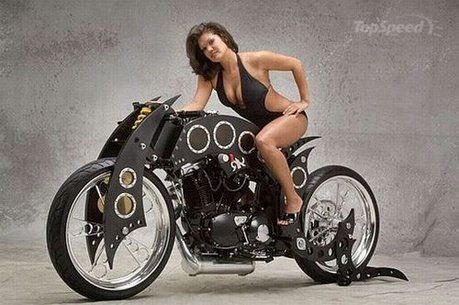 An amazing 'one family from new' Curtiss v-twin comes up for auction this Saturday at Midamerica's event in Minneapolis. It's a nice story; 'Great Uncle' buys a Curtiss v-twin new in '09 (that's 100 years ago folks), quite a nice machine in the day with a reliable and powerful inlet-over-exhaust v-twin of 1000cc, with direct belt drive and a rare clutch option.
An amazing 'one family from new' Curtiss v-twin comes up for auction this Saturday at Midamerica's event in Minneapolis. It's a nice story; 'Great Uncle' buys a Curtiss v-twin new in '09 (that's 100 years ago folks), quite a nice machine in the day with a reliable and powerful inlet-over-exhaust v-twin of 1000cc, with direct belt drive and a rare clutch option.Unfortunately, by 1917 the owner had a bad spill and broke his leg, and the Curtiss was laid up for the next 40 years. In 1957, the current owner, then 13 years old, had plans to revive the motorcycle with another Uncle, who fell ill shortly after, and the old bike sat in the family attic for another 50 years.... during which time the house had been abandoned! In 2008, the seller returned to the old house to find the Curtiss still there, with '1917 dust still on it'.

The Curtiss weighed all of 160lbs, and was good for around 60mph - truly a motorized bicycle, which reflects Glenn H. Curtiss' two-wheel racing experience. Curtiss grew 'the need for speed' as a young Western Union telegram delivery boy, where a quick delivery of a message often meant better tips from recipients, and the boss would often give more lucrative/important clients to the fastest cyclist.

Curtiss graduated from informal sprint challenges with other bicyclists, to a full-fledged track racer, and became a well-known champion on the East Coast, around Hammondsport, NY. His aptitude with mathematics, engineering, and tinkering was evident from a young age, and soon he began manufacturing bicycles with a 'Hercules' badge. In 1899 Curtiss purchased a 'loose' E.R. Thomas engine kit for his bicycle, called the Auto-Bi, a 1hp single...the resultant machine became known as the 'Happy Hooligan'! The engine was too weak for Glenn's taste, so he ordered the most powerful engine kit from Auto-Bi (3hp), which proved alluring but unreliable.

Curtiss felt he could do better, and with the experience gained building the previous engines, had castings made to his own design in 1901, and by the spring of 1902 he was marketing his own motorcycle, also called the Hercules, a single-cylinder machine which was sold at his 3 bicycle shops, in Hammondsport, Bath, and Corning. The engines were robust but light, and Curtiss pioneered the use of ball bearings throughout the engine, which reduced internal friction (compared to shafts running direct in poorly lubricated castings), and he claimed his motors produced the most power of any motorcycle available. By 1904, a racing motorcycle of 5hp began to make the rounds of competitions, and winning, and he journeyed to Daytona that year to participate in the open speed trials on Ormond/Daytona beach, breaking all the 2- to 10-mile records in the process, averaging 67.41mph for the 10-mile record.

By 1905, the 'Hercules' name was forcibly dropped, as another company was found to own the name, and henceforth his machines were simply 'Curtiss'. The range included 2.5hp and 3.5hp singles, and the 5ph twin, all with direct belt drive. His engines gained renown for their strength and reliability, two qualities in rare supply back in '05!

So reliable were his engines, in fact, that they attracted a certain 'Captain' Tom Baldwin, a circus performer turned daredevil, who travelled to county fairs all over the US in a hot air balloon. Baldwin wanted a good motor to power a dirigible, which he built in San Francisco. The subsequent 'California Arrow' became a regular sight in the Bay Area, and Baldwin entered a competition in St. Louis in 1904, with a prize of $100,000 - a phenomenal sum - offered to an aviator who could successfully fly to 2,000 feet, make a 3.5 mile loop, and land at the take-off point. Baldwin's machine was the only airship capable of making the course, and the response from the huge crowd was tumult, and demand for flight grew exponentially. Baldwin returned to San Francisco, where he built more dirigibles, until the 1906 earthquake levelled his factory, and he moved to Hammondsport to be near Curtiss.

This marked the beginning of the Curtiss aviation story, and soon the end of his motorcycle association, as he began to focus on building better motors for dirigibles and airplanes, becoming a legend of early flight, and the inventor of the Seaplane.

But his greatest motorcycle feat was yet to come; in a final bid to quench his speed lust, Curtiss built a spindly motorcycle frame around an experimental V-8 dirigible motor in 1906, and travelled again to Florida for a bit of sand racing. After the end of 'normal' speed runs with production bikes, Curtiss brought out his Behemoth with 40hp, and scorched through a 1-mile trap at an average speed of 136.3mph - the fastest speed of any powered human to date. His 'return' run was marred by the disintegration of the direct shaft-and-bevel drive used at the rear wheel (and should one be surprised, with an exposed u-joint, 40hp, and a sand bath?), and the rear wheel locked at speed while the drive shaft flailed away at the rider... but Curtiss' considerable track experience came to the fore, and he was able to haul the beast down without further drama. A true American hero.
Many thanks to Stephen Wright for his amazing 'The American Motorcycle; 1869-1914' - let's hope he publishes the next volume soon!








No comments:
Post a Comment